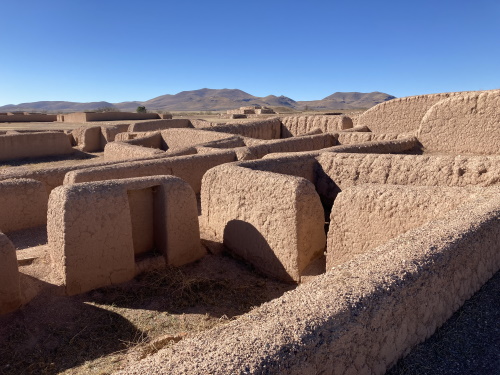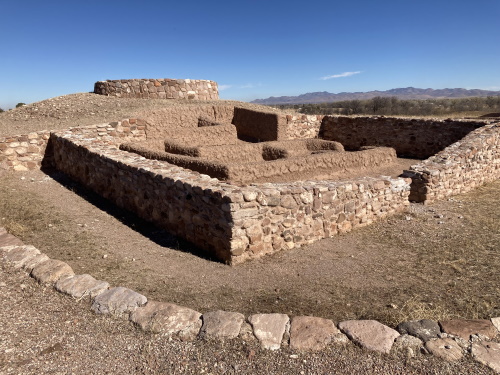Blog WHS Visits
WHS #765: Paquimé
Paquimé, located over 1,700 km north of Mexico City, is a site that is often overlooked. It doesn’t have the great monuments that other pre-Columbian Mexican sites are known for. It’s a niche site for archaeologists, exemplifying architectural and trading links between the area of the Classic Pueblo sites (now located in the Southwest USA) and Mesoamerica. Research has never been intensive, as archaeologists traditionally focus on either one of these worlds. But I was pleasantly surprised by its size and good condition. For me, it closed a circle after having already seen the other Puebloan sites of Mesa Verde, Taos, and Chaco. A visit also brings a lot of insight into the specific history of this region, always so far away from everything.
After walking past the still closed entrance barrier at the opening hour of 10 a.m., I was welcomed in by the guard and his German shepherd dog (I kept a safe distance, much more than 1.5m!) and sent on my way to walk the circuit that is signposted at the site. The first structure one encounters here is the ball court – it looks like a simpler version of the Mayan ones. The presence of a Mesoamerican ballcourt at Paquimé is often given as an example of the fusion of cultures that happened here, but the northern cultures had their own kind of ball courts as well and we do not even know whether they all played the same game.
The settlement consisted of several large residential compounds inhabited by family clans. In between them, structures for public use can be found, such as large ovens in which agave was turned into an alcoholic drink, irrigation canals, and places for religious ceremonies.
While preparing for my visit, I was most intrigued by the presence of bird pens for macaws. Although these birds are not found naturally in this desert area, they were kept and bred here. Their colourful feathers were used locally for religious rituals; the birds and feathers were also part of a lucrative trade with other settlements. Hundreds of bird skeletons have been found. On-site, a drawing shows how these bird pens were used: they used to have coverings and the birds were taken in and out via removing the plug at the front. The compound at the House of the Macaws even had special basins where they had their feathers removed.
The site in general looks well-looked after. The on-site museum is said to be excellent, however, this was closed when I visited in January 2022 due to maintenance reasons (this was not mentioned on their website, but my B&B owner had warned me). There is a fixed and signposted itinerary around the site that you have to follow. All along the route, there are information panels with texts in Spanish and English, adding to my knowledge even though I had read up well beforehand (see the links section for suggestions). It brought to light a few new connections, such as the astrological use of certain platforms and the clever canal system.
The visitor experience could be improved though: it is logical that you are not allowed to climb on the adobe walls of the buildings, but also you may not enter any of them. As all buildings are surrounded by earthen walls, it is hard to get a good look at the more interesting things inside the compounds. It would benefit from a couple of low viewing platforms like you see at Ancient Roman sites to be able to better view mosaics.
Getting there on public transport: best is to fly into the state of Chihuahua, to either Chihuahua or Ciudad Juarez. The city after which the dog species is named appealed to me more than the one associated with femicide. From Chihuahua, there are about 8 buses a day to Nuevo Casas Grandes. Both Omnibus de Mexico and Chihuahenses service this route, the bus I took continued to Nogales at the US border. Prebooking your ticket a day before (online, from a Mexican IP address) is advised. The ride takes about 4 hours. From Nuevo Casas Grandes it’s another 7km to Pueblo Viejo, the village where Paquimé is located. Taxis are available to cover this last stretch, as is an hourly yellow school bus.
Els - 16 January 2022
Comments
Michael Ayers 17 January 2022
Ughh.. It's too bad you couldn't see the museum, because I thought it really was the best part of that Site (of course, I have a particular fondness for ancient pottery, especially from the Americas.)
I have also been burned by the "official Website didn't mention that part/all of the Site is currently closed" problem more than once during the last few years. Would it be too much to ask for Sites to keep their sites up to date?...
Clyde 16 January 2022
very interesting info about the bird pens! thanks for sharing
Kyle Magnuson 16 January 2022
Great review and I'm happy to see that you visited this site! I've planned to go here for years. Eventually, I will just take another trip to Tucson (1-2 nights). From there, I will drive to Douglass, Arizona and stay overnight. The drive from Douglass to the Museum of the Cultures of the North is about 3.5 hours. There are a couple airbnb options that look pleasant near Paquime. On the return North, I thought about visiting the Janos Biosphere Reserve, in which the largest herd of American Bison roam the prairie.
Lastly, the Gila Cliff Dwellings National Monument (Silver City, New Mexico) has along with staff at Casas Grandes developed a working relationship and informal partnership to highlight the historical connections between their respective archaeological sites. Seemingly, still in the early stages, there are hopes of one day of establishing a binational tourist corridor.


